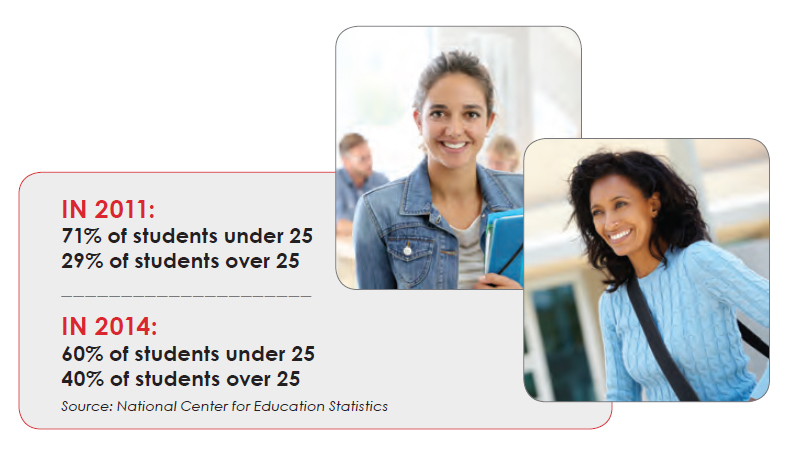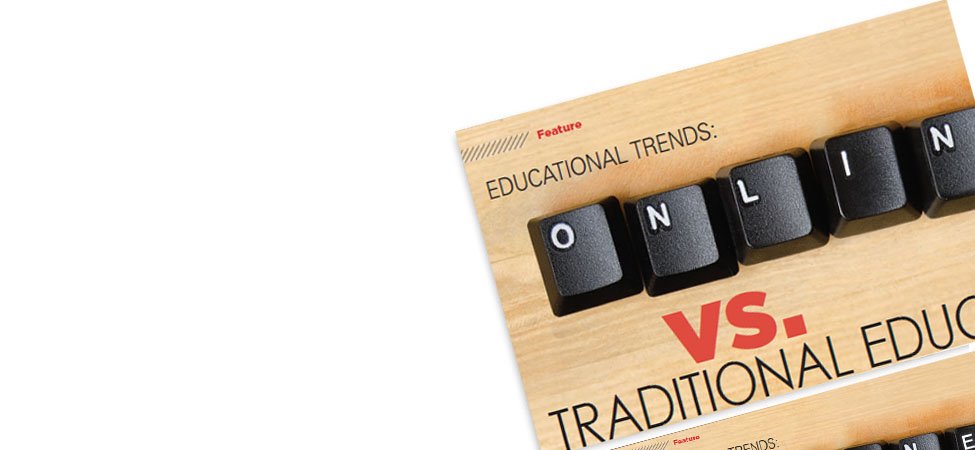AVAILABLE DEGREE PROGRAMS? SCHEDULE OPTIONS?
FINANCIAL AID?
Students have dozens of questions to answer in order to find the right college fit. But possibly one of the biggest decisions they will make is: online or traditional?
With innumerable online options on top of brick-and-mortar institutions, students have a wide pool from which to choose – and schools face more competition than ever before. A closer look at the various trends and market conditions affecting student enrollment at each type of school reveals just how critical it is for schools to carefully distinguish themselves and adapt to ever-evolving student needs.
The Online vs.Traditional Face-off
While the majority of brick-and-mortar schools have experienced declining enrollment numbers since 2011
(Fortune, 2016), online institutions are seeing an overall rise in their ranks. This disparity is due to a number of factors:
Online schools are largely proprietary.
It may seem like an unrelated circumstance, but this is actually a big contributor to online school growth.
Because proprietary schools closely monitor return on investment (ROI) to ensure their marketing is profitable,
they also tend to be more aggressive in implementing changes. Adjusting to market conditions allows schools to
be more effective in reaching target demographics and accommodating student demand, and proprietary
schools excel in this area. Reporting is a point of much needed improvement for traditional institutions. These
schools have historically been less diligent about tracking marketing ROI (perhaps simply due to inertia) and thus have been slower to adapt to changing tides, putting them behind the game.
Flexibility is a critical issue.
This factor reflects less on the school itself and more on the shift in student needs. There is a growing number of students age 25 and older, and these individuals generally have family and employment responsibilities in addition to their class load – thus, they need a school schedule that permits them to complete work on their own time. Online schools offer this opportunity.
While many traditional schools are trying to keep up with this movement, many would benefit from expanding their offerings to more online or hybrid options. Accelerated summer courses are another opportunity for traditional schools to reach the adult demographic. The more convenience brick-and-mortar schools can offer, the more they will appeal to working students.
Demographics are shifting.
In addition to the demographic shift toward older students, there is also an unusually high number of women enrolled in online programs. Women make up 70% of all online learners according to CollegeAtlas.org,
possibly because they tend to pursue more programs that require ongoing certification (i.e., education and healthcare), which may be completed online. Others speculate that this trend is, again, due to the flexibility of online schooling, which allows women with children to pursue their education while balancing family responsibilities.
Female students comprise the majority in conventional institutions as well, but not to such a dramatic extent.
Traditional schools that want to compete with online for this target should be ready to expand their certificate
programs and implement more diverse schedule options. This would not only capture the rising number of female enrollees, but also serve the dual purpose of reaching the rising number of 25-and-over students.
Cost matters to students.
 Tuition costs at online schools are generally comparable to the cost of in-state tuition at traditional institutions, with one big difference – room and board. Online schools obviously don’t need to charge for room and board, which gives them a cost advantage over their traditional counterparts.
Tuition costs at online schools are generally comparable to the cost of in-state tuition at traditional institutions, with one big difference – room and board. Online schools obviously don’t need to charge for room and board, which gives them a cost advantage over their traditional counterparts.
In a culture that is increasingly apprehensive about student loan debt, cost is a big determining factor for prospective students. Many traditional schools have been forced to raise their tuition due to state cutbacks, which, coupled with the on-campus expenses that accompany tuition, only contributes to student skepticism. Brick-and-mortar institutions that are already having revenue problems can’t afford to cut tuition, but they can continue to remind prospectives that their programs will deliver a sizable return to the student in the form of achieving future career goals.
Reputation Struggles.
One area where traditional schools do have a significant advantage over their online counterparts is in their reputation. Conventional institutions carry a significant amount of weight in the education arena, whereas a few instances of poor publicity has negatively impacted online schools as a whole. Online establishments still struggle to regain their reputational footing, which leads many to develop marketing that focuses around their strengths and student success rates to show that their goals are in sync with their students’ needs.
The Universal Call-Out
In 1999, Cisco CEO John Chambers predicted, “Education usage over the Internet is going to be so big it is going to
make email usage look like a rounding error.” The rise of online enrollment and simultaneous decline of traditional reveals he was absolutely correct, and that serious changes need to be made in the traditional model.
For some schools, transformation has come through augmenting traditional programs with online classes, or providing completely online program options. Schools like Arkansas State University (Talkbusiness.net, 2017) that have made this transition see a higher enrollment percentage than those that offer only in-person classroom experiences.
Online programs aren’t a passing trend – they’re rapidly becoming the preferred course for many students and traditional schools must adapt their methodology accordingly.
On the other hand, online and traditional schools can both improve their attention to rising industry needs. A progressively technology-driven culture has shaped the demand for new talent in fields like analytics and coding, and schools that are continuously projecting emerging career fields and developing corresponding programs will thrive due to their relevance and focus on student success.
Further Progress for the Trads
But if a traditional school doesn’t have the ability to expand its programs, slash tuition, or increase scheduling options, how can it adapt to these changing needs?
There are two ways to accomplish this: a detailed analysis of ROI, and clear messages in marketing.
ROI is a critical metric and, as mentioned previously, one that traditional schools tend to neglect. These institutions can no longer afford for this to be the case.
By regularly gauging ROI, schools know exactly where the majority of inquiries are coming from and how to best engage with them. As a result, departments can better judge how to allocate funds to eliminate waste while still
increasing enrollments. Better yet, knowing where the inquiries come from gives insight into how to improve the chance of them becoming enrollees and indicates whether they will be students with a higher lifetime value.
Is the cost-per-enrollment (CPE) delivering the anticipated end return?
If not, where is the breakdown occurring?
What should the CPE of a specific program be, based on the cost of the program itself?
- Which programs yield the best lifetime value, and how do you market these programs more effectively to gain enrollments?
- By asking these questions as you examine your ROI data, you can uncover any weaknesses in your marketing, programs and tuition rates, and make changes wherever necessary to increase profitability.
But measuring ROI will only be effective if paired with clear, relevant marketing messages that garner interest in the first place. And for traditional schools, this will mean appealing to the main benefit they offer over and above online schools: a well-rounded experience.
Online schools are focused on students who have a clear-cut career path in mind, and their programs are tailored and concentrated to fit these paths. However, online degrees can’t offer the kinds of challenges, connections and sharpening that occur in the context of an in-person college class. So while an online student and a traditional student may get the same bachelor’s degree, their knowledge base will differ in some respects – purely due to their differing experiences.
This will be the main point of emphasis for traditional schools that want to remain competitive in an online market. Having a degree does not connote ability. Brick-and-mortar schools need to drive home the main point: the experience gained throughout education is just as important as the degree itself.


